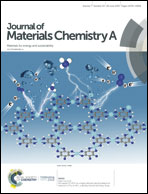The surface engineering of cobalt carbide spheres through N, B co-doping achieved by room-temperature in situ anchoring effects for active and durable multifunctional electrocatalysts†
Abstract
Zinc–air batteries and full water-splitting devices, as environmentally friendly electrochemical energy storage and conversion systems, have drawn extensive attention. However, effective, low-cost and durable electrochemical catalysts for the involved oxygen reduction reaction (ORR), oxygen evolution reaction (OER) and hydrogen evolution reaction (HER) are highly desired. Herein, a new N, B co-doped Co3C multifunctional catalyst with enhanced ORR, OER and HER activities, as well as improved ORR and OER stabilities, in alkaline media has been synthesized. The strategy used, immersing N-doped Co3C in NaBH4 solution, not only achieves N, B co-doping via the N anchoring effect to B at room temperature for the first time, but also engineers the outmost surface of Co3C-N by forming nanosheet arrays. Besides, Co–Nx–B and N–B bonds have been successful produced via the anchoring effect of N during the immersion treatment, which is proved by the X-ray photoelectron spectroscopy (XPS) results. In particular, both liquid and solid-state Zn–air batteries that are equipped with Co3C-NB as air-cathodes all exhibit superior cycling stabilities over those with Co3C, N-doped Co3C and Pt/C + IrO2 air-cathodes. Furthermore, a Co3C-NB-based full water splitting device can be successfully driven using two solid-state zinc–air batteries with a Co3C-NB air-cathode in series.



 Please wait while we load your content...
Please wait while we load your content...